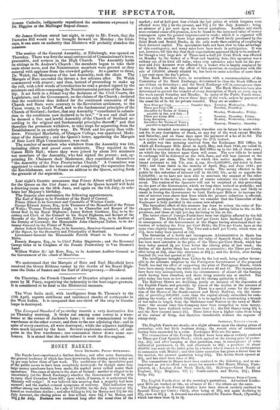The session of the General Assembly, at Edinburgh, was opened
on Thursday. There was first the usual ceremonial of Commissioner's levee. procession, and sermon in the High Church. The Assembly holds its sittings in St. Andrew's Church : the members began to take their seats about noon, and the Nonintrusion members were greeted as they entered with applause from the crowded gallery. At a quarter to three, Dr. Welsh, the Moderator of the last Assembly, took the chair. The Marquis of Bute ascended the throne a few minutes after. Dr. Welsh commenced with prayer ; and then, instead of proceeding to make up the roll, with a few words of introduction he read a protest signed by the ministers and elders composing the Nonintrusionist portion of the Assem- bly. It set forth in a formal way the decisions of the Civil Courts, the Legislature, and the Government, on the claims of the Church ; declared that the oonditions thus defined for the continued connexion of the Church and State were contrary to the Revolution settlement, to the Union treaty, to God's Word, and to the fundamental principles of the Church of Scotland ; further, that any Assembly "constituted in submis- sion to the conditions now declared to be law," "is not and shall not be deemed a free and lawful Assembly of the Church of Scotland ac- cording to the original and fundamental principles there;" and that therefore the protesters withdrew, to take steps for separating from the Establishment in an orderly way. Dr. Welsh and his party then with- drew. Principal Maefarlan, of Glasgow College, was appointed Mode- rator of the Assembly ; and the Queen's letter, appointing the Marquis of Bute Lord High Commissioner, was read. The number of members who withdrew from the Assembly was 169, including elders and guoad sacra ministers. They repaired to the Canon Mills Hall ; where they were joined by about 300 ministers not members of the Assembly, who had signed the protest ; and, ap- pointing Dr. Chalmers their Moderator, they constituted themselves " the Assembly of the Free Presbyterian Church." A Committee was appointed to consider the best course of completing the separation from the Establishment, and to frame an address to the Queen, setting forth the grounds of the separation.


























 Previous page
Previous page